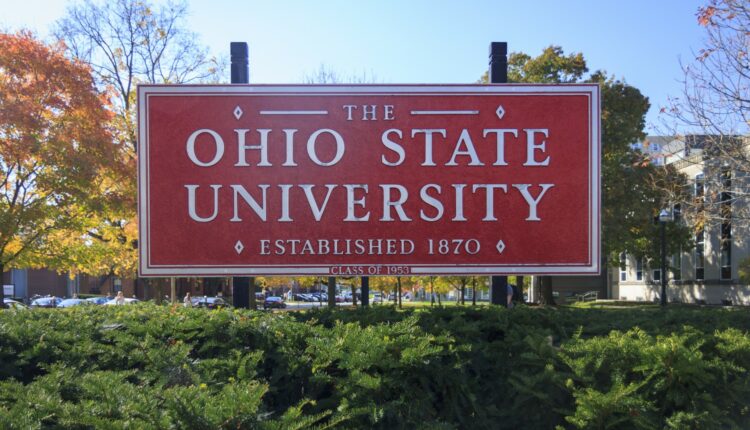Ohio State Motorsport Teams Secure National Titles
The College of Engineering at The Ohio State University is home to not one, but two national championship-winning motorsports teams.
This spring, the Formula Buckeyes won the Formula SAE Michigan competition, beating 107 other teams in contests that measured endurance, acceleration, business acumen, cost and more.
The EcoCAR Electric Vehicle (EV) team, a collaboration between Ohio State and Wilberforce University, won year two (as well as year one) of the four-year challenge to build a next-generation EV that is energy efficient and pleasing to customers, while meeting the automotive industry’s decarbonization needs.
As if that weren’t enough, the university’s Battery Workforce Challenge team placed second in its first national three-year competition that asks teams to design, build, test and integrate an advanced EV battery pack in an electric van.
Performing at this level requires a commitment similar to the university’s student athletes, who log hour after hour practicing and preparing for games, said Zach Petty, a Formula Buckeye team member who graduated in May with a master’s degree in industrial and systems engineering.
“The time people put into this car, we’re talking 40-plus hours a week,” he said. “And a lot of us have been doing it for four years. For that to culminate with a winning car and a successful weekend, it was a great experience.”
Career preparation
There is more to these cars than building them. Students raise funds, seek out vendors and engage with media. Petty supported the business side of the Formula Buckeye team. This meant identifying sponsors and equipment vendors. Building these relationships early can be beneficial to students and suppliers down the road.
“We’ve focused on new partnerships with local companies. We hope they’ll want to recruit our engineers or get visibility through sponsoring the team,” he said. “And if our engineers work with your company or go to your facility, they’re going to think of you in the future. Whether that’s job hunting or needing certain materials or supplies, they’ll think back to companies they worked with previously.”
Real-world practice, another benefit of the competitions, is invaluable, said Ian Campbell, an EcoCAR EV team member and mechanical engineering graduate student.
“The competition takes place at the actual General Motors proving ground in Yuma, Arizona,” he said. “You can feel how serious things are.”
Campbell’s EcoCAR teammate Suhrit Chowduri echoed how important developing these skills can be.
“This is practical experience,” he said. “What we learn is used in a lot of industries, so it prepares me for the job field. All of the skills, all of the software we use are central to this industry, to the companies we want to work for.”
Collaborating with other institutions
Two of Ohio State’s Motorsports teams, the EcoCAR EV and the Battery Workforce Challenge teams, collaborate with other institutions.
The EcoCAR EV team works closely with Wilberforce University, a historically Black university in western Ohio. Both schools’ logos are emblazoned on the hood of the Cadillac Lyriq they’ve been working on since the fall of 2023.
Pranay Ketineni, a second-year graduate student, believes input from a variety of people only strengthens the team.
“Every time we have someone new, either an undergraduate or someone from Wilberforce, they bring fresh ideas and fresh questions,” he said. “Asking those questions gives us a different perspective on how to solve a problem.”
David DeLisle, another second-year graduate student, agrees.
As a member of the Battery Workforce Challenge team, he and other Buckeyes work with Columbus State Community College students. The group won an award at this year’s competition for their collaboration, he said. Recognizing the strengths of Columbus State’s vocational programming was key.
“We asked ourselves, ‘How do we take their creative insights and their vocations and integrate it into the engineering design process?’” he said. “I love collaborating with the students and faculty at Columbus State. It’s been a fantastic experience.”
DeLisle said his fellow motorsport Buckeyes have also been great partners.
“It’s awesome to have a bunch of sister teams here,” he said. “All the different knowledge bases and the sheer amount of collaboration that happens between the different teams, it really speaks to this unique environment. It allows new teams like us to come in and perform successfully in our first year.”
Learning in real time
While the planning, developing and testing are all exciting for students, nothing beats the adrenaline that accompanies competition, Petty said. Teams often have to troubleshoot in the moment.
“You’re at the track and you’re thinking, ‘Have we covered our bases? Have we made it work?’” he said.
The manufacturing stage, though, is where the majority of problem solving happens, he said.
“People are spending 40 to 80 hours a week making this car. We’re doing as much as we can to figure out what can go wrong and how to prevent that,” he said. “Maybe it’s upgrading a system or changing how something is put together. It’s fun to sit here in the shop together and bond through that.”
For Ketineni, teaching younger students is just as rewarding as his own education.
“Every year we have undergrads who join with no idea how a car is built,” he said. “The first time they get to see the engineering behind it, they want to learn everything.”

